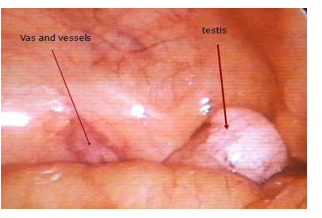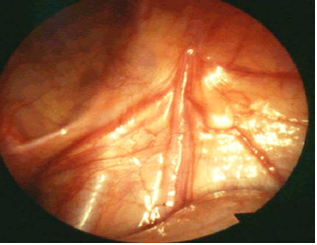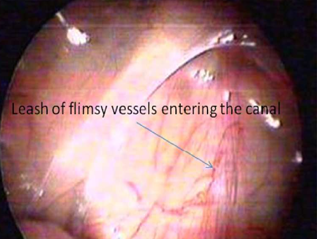Agentic Absent testis, Does it Exist?
- 1. Department of Paediatric Surgery, Burjeel Hospital, UAE
Abstract
During surgical exploration for undescended testes (UDT) a situation arises where no testis could be found and labeled as an absent testis. An absent testis either unilateral or bilateral cannot exist without the presence of ipsilateral mullerian structure in unilateral cases and phenotypic appearance of female in bilateral ones. Understanding the embryological development of the testis and epididymis helps to avoid missing an existing testis at high or hidden abdominal position.
Keywords
• Agenetic testis
• Laparoscopy
• Testicular vessels
Citation
El Gohary MA (2017) Agentic Absent testis, Does it Exist? JSM Pediatr Surg 1(1): 1002.
INTRODUCTION
Normal testicular development and descent depends upon a complex interaction among endocrine, paracrine, growth, and mechanical factors. Bipotential gonadal tissue begins differentiation into a testis during the 6th and 7th weeks of gestation under the effects of the testis-determining SRY gene. There are situation in which no testes are found either during open groin exploration or during diagnostic laparoscopy and labelled as absent testis. Understanding the embryological process of testicular descent defies the possibility of absent testis in normal phenotypic males.
DISCUSSION
Absent testis during groin exploration
As the vas and epididymis develops embryologically separate from the testis [1], finding the vas and epididymis alone with no testicular vessels does not exclude an existing testis in abnormal locations or merely separated from the vas. Testicular epididymal separation allowing epididymis to elongate and descent to the scrotum without associated testicular descent is a known phenomena [2], but there are rare situation of complete urogenital nonunion in which there are no communication between the descended epididymis and the UDT [3-5]. An extreme example of this was one of our reported cases in which the vas enters closed internal ring and a normal testis lying completely dissociated from the vas in the pelvis (Figure 1) [6].
Figure 1 Failure of fusion between epididymis and testis.
This particular case would have been labeled as an atrophied testis, based on the groin exploration without diagnostic laparoscopy. The explanation to these phenomena is related to the separate embryological development of the wolfian system from the testis with the gubernacular attachment to the epididymis rather than the testis [7].
Absent testis during diagnostic laparoscopy
When no testis could be identified during laparoscopy, the vas and the testicular vessels are traced as leading points for testicular localization. The testicular vessels are a good landmark for testicular localization and there is a relationship between the size of the feeding vessels and the testicular tissue [8,9]. Visualizing of well-developed spermatic vessels predicts the presence of a good-sized testis whereas poor blood supply is invariably associated with poorly developed or atrophied testes. If no testes are identified, one is left with the possibility of vanishing or absent testes. Vanishing abdominal testes are readily diagnosed when a blind-ending vas meets a leach of flimsy
Testicular vessels, and are thought to result from a prenatal vascular accident or intrauterine testicular torsion (Figure 2).
Figure 2 Vanishing testis.
Agenetic testes in a 46, XY individual do occur if the gonadal ridge fails to form or its blood supply fails to develop. Individuals with bilateral testicular agenesis or those individuals in whom the testes are lost before the 9th week of gestation, will end into a phenotypic female. In unilateral cases of agenetic testis an ipsilateral Mullerian structures will be present due to failure of secretion the paracrine Mullerian inhibiting hormone (MIH).
The key clinical sign indicating testicular agenesis rather than a vanished testis is the presence of ipsilateral Müllerian structures. True congenital absence of one testis is virtually impossible in a phenotype male with no remnant of Mullerian structures on the affected site.
Cases that was initially diagnosed as absent testes in our series turned up to be related to rare subset of abdominal testes reported as none descent of the testis [10]. Testes were located at their initial embryological position below the kidneys, in contrast the high abdominal testes which are present along the line of descent at a variable distance from the internal ring .This entity was realized when, during routine laparoscopy for impalpable testes, a leach of what looked like flimsy vessels were encountered entering an open internal ring, with no vas associated with it. The initial impression was that of an absent testis (Figure 3).
Figure 3 No testis or vas during initial laparoscopy.
During further inspection a vas was found hidden under the caecum and going in an upward direction toward the right hypochondrium. When followed the vas was seen to join the epididymis which was attached to a sub renal testis [10]. The etiology might be attributed to poorly developed or absent gubernaculums .The gubernaculum is known to be attached to the epididymis and plays an integral part in testicular decent and its poor development may explain testicular none descent. This is highlighted by the fact that the only trace of gubernacular tissues in these cases was a leach of vascular tissues resembling flimsy vessels, along the course of testicular descent. There are 2 reports of sub renal testes with initial finding at laparoscopy very similar to our cases, but with the difference that they had no vas or epididymis [11,12].
CONCLUSION
When no testis could be identified during laparoscopy, the vas and the testicular vessels are traced as leading points for testicular localization. As the vas develops separately from the genital ridge; its absence does not exclude the presence of a testis in an unusual location. Testicular vessels proved to have high accuracy as a land mark for the developing testis; and its size has a relationship with the fictional testicular tissues, however poorly developed gubernaculums can easily be mistaken for hypoplastic testicular vessels. Subrenal none descended testes represent a variant of abdominal testes that are likely to be missed unless one is aware of its possible anatomical location. In this subset of cases there are no vas at initial laparoscopy and what looks like flimsy vessels represent poorly developed gubernaculum. Based upon embryological facts of testicular development, in a phenotypically normal male it is virtually impossible to be associated with bilateral agenetic testis, In unilateral agenetic testis, an ipsilateral
Mullerian structure has to be present. The absence of Mullerian remnants means that there has been a testis at one stage of development that survived well above the 9 week of gestation. There are reported cases in which the testis was absent duringinitial laparoscopy and was subsequently found under the renal lower pole; which makes laparoscopic examination of the site of origin below the kidneys an essential step in all cases apparent
Absent testes. We do believe that testicular absence does not exist in normal males and that cases that were labeled as (absent testes) should be re-scoped to exclude sub-renal testes.
We would like to suggest that all cases diagnosed as an absent testis has to be re laparascoped with diligent search for subrenal testes.











































































































































